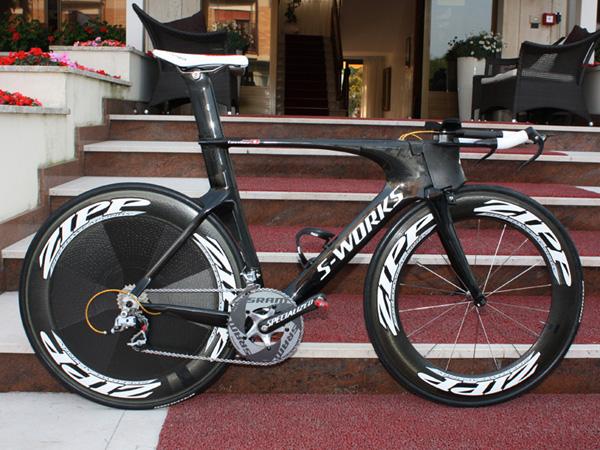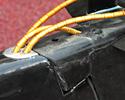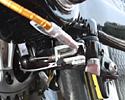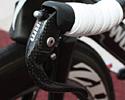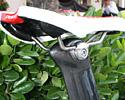
Recently on Cyclingnews.com |
Pro bikes, May 9, 2009
Fabian Cancellara's Saxo Bank Specialized S-Works TTR prototype
By James Huang in Lido di Joselo, Italy Saxo Bank time trial and classics specialist Fabian Cancellara arrived at this year's Giro d'Italia with a brand-new aero prototype that he has been testing over the past several weeks. Currently nicknamed the Specialized S-Works TTR (for 'time trial Riis', according to team rider development manager Bobby Julich), the new bike's more organic shape is a drastically different machine from his previously more angular Transition. The TTR's most defining feature is undoubtedly the highly integrated front end. Whereas Specialized had previously angled the Transition's top tube to fall behind the stem in an effort to smooth out airflow, the TTR now sports a proprietary stem situated perfectly in-line with a now-level top tube similar to what Giant – and now Scott – have done with their latest aero machines. Extending below the stem and situated in front of the head tube is a secondary 'nosecone' that effectively increases the aspect ratio of the combined elements to far greater than 3:1, thus apparently skirting around the applicable UCI rule. Don't call it a fairing, though; while Felt and Giant apparently get away with their extensions because they either reinforce or are the steerer tube, Julich says that the TTR's nosecone should be considered a structural element because it provides the sole mounting point for the front brake. Cancellara's TTR also ditches the Transtion's kinked seat tube in favour of a slightly more conventional straight design with a deep rear wheel cut-out and easily adjustable telescoping carbon aero seatpost – which even sports an aero-shaped head. As before, the integrated rear brake is mounted below the chain stays – thus making for a smoother junction around the top of the seat stays and seat tube – and both the seat stays and chain stays closely follow the rear wheel before making an abrupt turn out towards the rear-facing aluminium rear dropouts. Naturally, all of the cables are internally routed with the entry point in the frame being the now-standard top of the top tube, right behind the stem. Parts-wise, most of Cancellara's other bits are rather standard such as the SRAM Red group, Zipp carbon tubular wheels, and Specialized integrated carbon crankset. The front SRAM carbon brake lever has been modified to accept a small barrel adjuster since the nosecone makes the front brake cable rather inaccessible after installation and shifters are the company's new 1090-R2C model with levers that always return to the forward position after a shift for marginally reduced drag. Team sponsor Prologo have also provided Cancellara with a new prototype saddle developed just for time trials. The nose is especially broad and heavily padded with surprisingly soft foam, and also rather short to facilitate a more forward position while still adhering to UCI guidelines for setback. Grippy appliqués up front also presumably help Cancellara maintain his position on the nose and perforations in the shell softer that area up even further. Time will tell just how long Cancellara's TTR will stay in this precise configuration however. Julich suggested there might be some elements of the bike that may not pass muster when the UCI begin their more stringent equipment rule reinforcement July 1 though supposedly only minor changes will be required. Come Tour de France time, it stands to reason that Specialized may outfit the rest of the team with similar rigs so we'll have to wait until then to see what – if any – modifications have been made. All told, Cancellara's new TTR weighs 8.1kg (17.86lb) – a bit above the minimum limit but still admirably feathery for a dedicated time trial machine. Regardless, Stage 1's dead-flat team time trial course on Lido di Venezia won't require much in the way of gram-shaving and if Cancellara's new bike is as fast as it looks – and if his legs churn out their usual freight train-like power – we'll allow two guesses as to who'll be taking the longest pulls on the team. PhotographyFor a thumbnail gallery of these images, click here Images by James Huang/Cyclingnews.com
| |||||
Full specificationFrame: Specialized S-Works TTR prototype Critical measurements
Front brake: Specialized S-Works integrated |
Rear wheel: Zipp 900 disc tubular Pedals: Speedplay Zero Titanium Total bicycle weight: 8.1kg (17.86lb) | ||||

